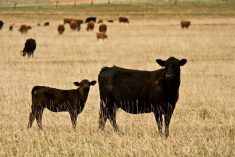Compared to last week, western Canadian yearling markets traded $2-$3 higher, with quality packages advancing $4-$6.
Feedlot operators shrugged off the weaker live cattle futures as feed grain prices came under pressure. Cattle brokers were carrying a full deck of orders, which allowed for limited slippage. Feedlots are anxious to secure ownership early in the fall run because stronger fed cattle values are expected in the first quarter of 2019.
Secondly, yearlings are quite thin with very little butter at this time of year. These early placements tend to perform better, so feedlots feel they can be more aggressive. Much of Western Canada has experienced below-normal precipitation over the past 30 days and larger volumes will come on stream over the next couple weeks. Currently, the market is characterized by many aggressive buyers and few feeble sellers. Ranchers are buying time with the market up almost every week.
Read Also

U.S. grains: Soy futures post biggest monthly gain in nearly five years on China trade optimism
U.S. soybean futures climbed to a 15-month high and posted their biggest monthly gain in nearly five years on Friday following a rally fueled by the prospect of revived exports to China.
In east-central Alberta, a load of larger-frame steers averaging 1,000 lbs. sold for $188; a larger group of steers averaging 965 lbs. reached up to $189 in central Saskatchewan. In southern Manitoba, 850-lb. steers traded over the psychological level of $200, reaching up to $204. A smaller group of medium- to larger-frame mixed steers weighing 868 lbs. sold for $205 in central Alberta. Yearling prices were quite even across the Prairies. Ideas are that total western Canadian yearling supplies will be down this fall by three per cent to as much as five per cent from year-ago levels.
Calf volumes were limited with variable quality. Angus-based mixed steers averaging 600 lbs. were quoted at $218 landed in southern Alberta; similar-quality heifers averaging 570 lbs. were reported at $197. Larger-frame mixed steers averaging 760 lbs. traded for $217 in central Alberta.
The U.S. Department of Agriculture’s report on Friday was bearish for feed grains due to the record corn yield. Third-quarter beef production was revised lower. Both of these factors should be supportive for the feeder market moving forward.
— Jerry Klassen manages the Canadian office of Swiss-based grain trader GAP SA Grains and Produits Ltd. and is president and founder of Resilient Capital, specializing in proprietary commodity futures trading and market analysis. Jerry consults with feedlots on risk management and writes a weekly cattle market commentary. He can be reached at 204-504-8339.













